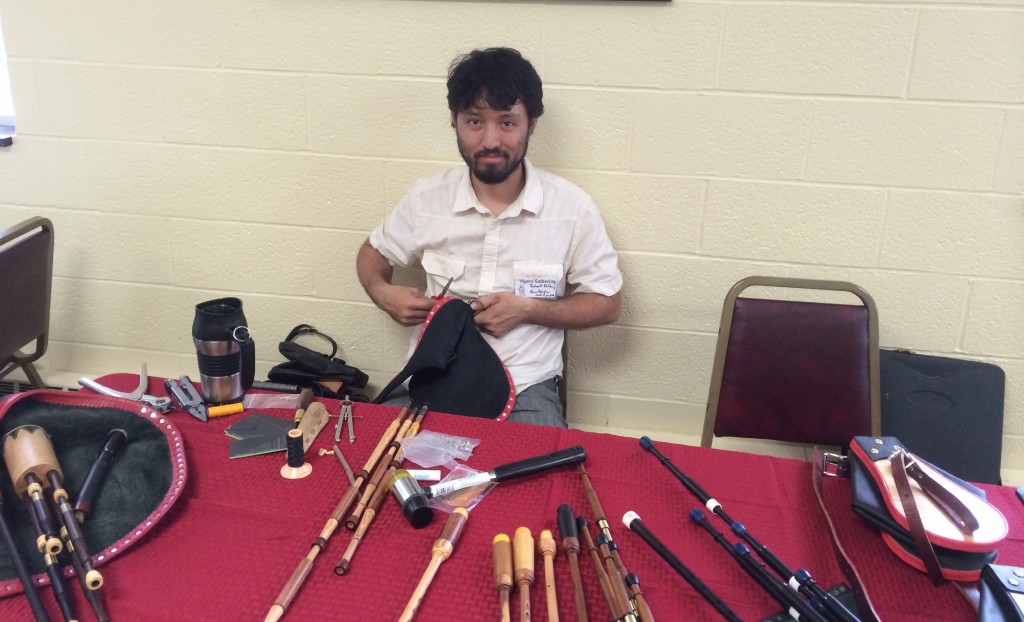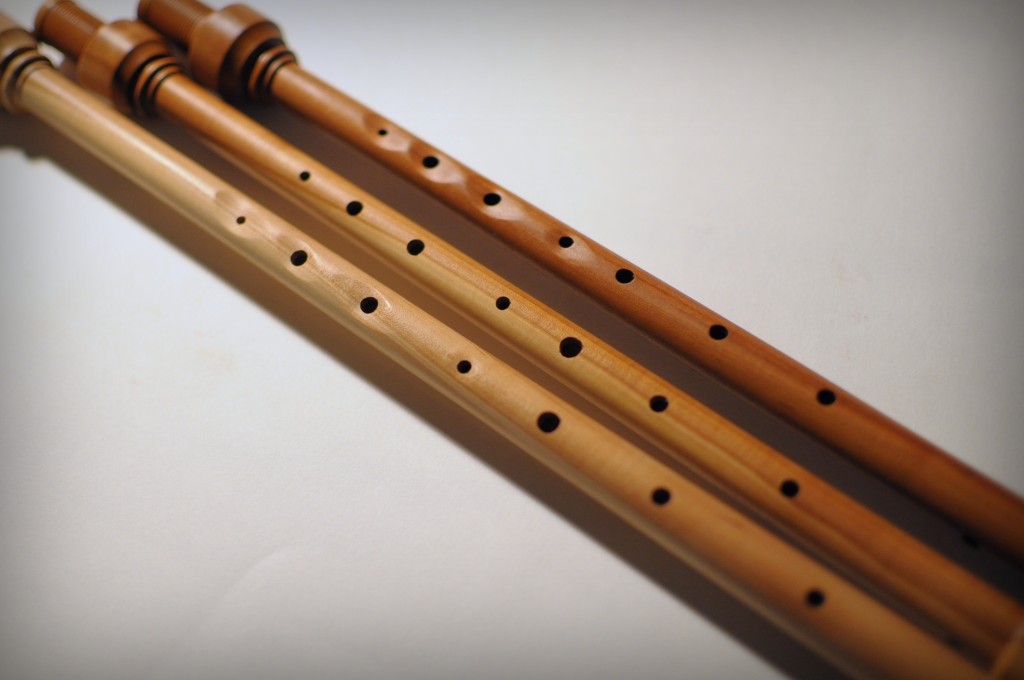By Michael Simone
One of North America’s newest smallpipe makers is Robert Felsburg of Pittsburg, Pennsylvania, who recently started business as Quietpiper Scottish Smallpipes. More about Rob and his work can be found on Facebook.
Rob, how did your music playing start, what instruments and kinds of music? How did your musical interest evolve?
Growing up we always had music playing in the house. I listened to everything. From Bob Dylan to The Beatles to U2. Naturally, I gravitated towards wanting to play guitar because my Father played. It’s a really beautiful, versatile instrument. I progressed through a few different genres like rock, folk, and blues. But I really started to get more serious about music when I began studying classical guitar and renaissance music. With that classical foundation, picking up other instruments like mandolin, wooden flute, bass, and pipes was a bit of a release.
How long have you been playing the pipes? What engendered your interest?
I’ve been playing the pipes now for about 18 years. I began with a practice chanter, then a set of smallpipes, followed by the Highland pipes. I’d say I’ve always had a strong interest in bagpipes. My grandmother had a few cassette tapes that I loved listening to when I was younger. It was mostly military pipeband music along with some Scottish and Irish folk music.
Which pipes do you play and what is your favorite version?
I play Highland pipes, Scottish smallpipes, Border pipes, and I have dabbled with Uilleann pipes.
Without a doubt, my favorite are the Scottish smallpipes pitched in A. Smallpipes in C would be a strong runner up.
Do you play bellows blown pipes? Why or why not?
Absolutely! In my opinion bellows are a necessity for smallpipes and Border pipes. It’s the only real answer to the moisture and reed problems those pipes face. Other solutions, like plastic reeds and drying systems, seem to be more of a compromise.
Who has been your biggest influence?
For piping, Iain MacInnes and his smallpipe playing with the Tannahill Weavers was the biggest influence and reason I took up the smallpipes. For woodworking: George Nakashima, a furniture maker in New Hope, PA. From his work I learned respect for natural materials, the fine balance of design and function, and a reverence for craftsmanship.
What inspired you to make the leap to crafting your own instrument?
Well, I wanted to make my own pipes since the time I first started to play the instrument. I feel like I’ve always been a craftsman of some sorts and I am naturally inquisitive about how instruments work and are constructed. My father was a craftsman and I grew up attending arts and crafts shows on the weekends where he would sell his work. Seeing first-hand how things are made and experiencing traditional crafts through my interactions with all of the other craftspeople at shows inspired me as well. By chance, at one of the craft show demonstrations I was fortunate to watch a Sackpipa being made on a spring pole lathe. I was amazed that bagpipes could be made in that manner, and I’ve been working at figuring it out ever since. Getting the instruments to sound how I want them to and developing my craftsmanship has been a long journey.
How did you start getting into pipe making as a profession?
I studied Furniture design and woodworking in college intending to set up a studio furniture business. With the economy taking a downturn, I witnessed some exceptional furniture makers and shops struggling to stay in business. That forced me to rethink some of my plans. Considering my options after school, pipemaking had been on my mind as something I would like to pursue that could be done on a smaller scale than furniture. At the time I was also learning a bit about repairing instruments. As things go, working on repairs and learning the ins and outs of old instruments served as an inspiration for my own work. Now I’ve been concentrating on just making my own design of bellows blown pipes.
Tell us a bit about your reed making.
Reedmaking, to me at least, is about equal parts science, practice, and luck. Every piece of cane presents its own challenges and struggles in making a good sounding and playing reed. Getting consistent results with chanter reeds is something you have to really work hard at and put time into. I do find enjoyment in experimenting with different techniques, materials, and methods of making reeds.
Who were some of your mentors, instructors, and inspirations in pipe making?
Jimmy MacIntosh was a big influence and source of valuable information on repairs, vintage Highland pipes, and tone. As far as bellows pipes are concerned, I admire the work of many fellow makers. Hamish Moore, Nate Banton, EJ Jones, Mike MacHarg, and Colin Ross come to mind easily. Lately I will admit to drawing a lot of inspiration from continental European pipemakers.
When did your business begin? Was it part time at first? Is it still? And how many sets have you made to date?
I started taking orders for pipes in 2012 and have made about 30 sets so far. It’s been part time for me as I grow the business and build my reputation.
What are you trying to achieve or provide that other makers don’t?
I’m after a really big sound for the smallpipes. The most common complaint that I hear about the instrument from pipers is that the volume is too quiet and the sound too easily lost in a mix with other instruments or even with a little background noise. So I have worked at developing a louder chanter and loud robust drones that will balance with it and stand out.
Something else I do that is unique to the smallpipe chanters I make are the hand carved scallops on the top hand notes. I do this for a few reasons such as ergonomics. The top hand holes are usually the more difficult ones to feel. So, by scalloping I am creating a comfortable groove that your fingers will naturally fall into. The carving also has an effect on tone. By cutting the scallops it decreases the chimney height and helps to open up the sound. Another reason for leaving a thicker diameter on the upper part of the chanter is for stability. Having more mass in that section will help the chanter to resist warping and breakage better.
This is just a little bit of insight into the thought and design process I go through when making small pipes. Every detail and part of the pipes I make is subjected to the same meticulous careful scrutiny. I do pride myself on making every component in house. I make bags, bellows, reeds, pipes and chanters. Everything from elbow to ear.
Discuss the bread and butter of your business, and what do you enjoy doing the most?
Converting Highland pipers to Scottish smallpipers. It’s such a logical transition. The fingering is the same and most of the tunes translate well to smallpipes.
What have been some of your most difficult challenges?
For me it’s time and materials. Time always seems to be in short supply. I have to find a way to balance the time I spend turning pipes, tuning chanters, making bags and bellows, reedmaking, corresponding with customers, sourcing materials, researching better production techniques, and developing new designs. Sourcing quality materials always seems to be a challenge as well. I only work with the best materials available, whether wood or leather, and that quality comes at a premium.
What are your materials, style and key preferences?
I really enjoy working with the fruitwoods and domestic species like Cherry and Curly Maple for stocks and bellows. There is something satisfying about being able to go outside my shop and seeing trees growing that can be turned into bagpipes. And of course I also enjoy the tone of some exotic woods like Mopane and Honduras Rosewood. I think the most useful key is A. But if I’m just playing by myself, smallpipes pitched in C sound terrific.
Can you talk about some of the technical challenges in creating your pipes?
To be a pipemaker you have to be something of an inventor. The tools necessary to do the job are not readily available so you have to invest a good deal of time in making and learning to make your own so the job can be properly done.
What is your opinion on the current quality of instruments compared to historical instruments?
As far as Scottish smallpipes goes, I feel that the potential quality of instruments being made now has greatly improved. The historical examples of smallpipes we have surviving were something of a parlor instrument using finicky reeds. Many of the old smallpipes were of a miniature Highland type and they seemed to be an afterthought made by Highland pipemakers on the side, rather than by pipemakers specializing in smallpipes. Reedmaking is at a very high level now as well and the instrument has really come into its own as an instrument and not just a practice “toy”. But if we are talking about Highland pipes, then I’d say there are only a few makers I regard as being as good or better than the classic pipemakers in terms of sound and craftsmanship.
Have you had any apprentices, associates, employees?
No, I haven’t. I make every piece and part and enjoy that process and want the complete quality control of the work coming out of the shop.
What are your thoughts about your business after you can’t or don’t want to continue with it?
I can’t really fathom a time that I would stop making pipes. If that happens, I’m done. Just set me off to drift on an iceberg.
What musicians to you like listening to?
Chris Ormston, Gordon Duncan, Nic Jones, Bill Evans, Segovia. There’s really a lot of music I enjoy.
Please feel free to add any thoughts, observations, etc.
I would like to take the time to thank you and everyone involved with the APNA for this opportunity and for the hard work that has gone into the website and articles.


